Minolta Rangefinder Cameras
A Description of Minolta Rangefinder Cameras produced 1947-1959
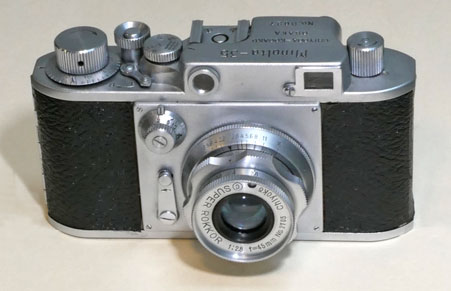
Minolta-35 Model A (or original) of 1947
Some Minolta History
Minolta was started in Osaka 1928 by Kazuo Tashima, born 1899 and who remained the central figure in Minolta until 1982.
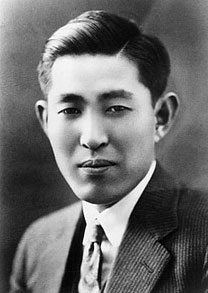
Kazuo Tashima in the 1930s
Kazuo Tashima was born in Wakashima, Japan near Tokyo, on November 20, 1899. The Minolta company history states:
"...in 1928 28-year-old Kazuo Tashima agreed to represent his father's import-export company, Tashima Shoten, on a government-backed trade mission to Paris to promote Japanese silk. In Paris Tashima toured a factory that specialized in high-grade optics, and decided he could produce similar equipment in Japan profitably. Japanese businessmen, including Tashima's father, opposed the idea of producing optical equipment domestically. Unable to start his new venture as a part of Tashima Shoten, Tashima borrowed money from his father's chief clerk and went into business on his own."
"Tashima opened shop on November 11, 1928, calling his venture Nichi-Doku Shashinki Shoten (Japan-Germany Camera Company). The name reflected the company's reliance on German technology and expertise. Partners Willy Heilemann, an importer of German items in Kobe, and Billy Neumann, a German engineer with a background in optical instruments, brought state-of-the-art German technology to the new firm. By March 1929 the staff of about 30 was producing each day one bellows camera, called the Nifcalette, with imported lens and shutter. Within three months, production had grown to 100 cameras a month."
The Minolta name of Nichi-Doku Shashinki Shoten - にちーどく しゃしんき しょてん can be translated as "Japanese-German Camera Workshop" or "Camera Store". Using the Nifca brand name, his first camera was called the Nifcarette. This was a folding camera taking Kodak 127 film. It was launched in 1929.
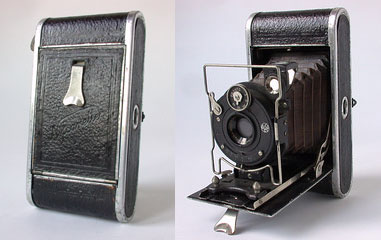
the 1929 Nifcarette
In 1931, Tashima renamed the company Molta, and for the first time, the Minolta brand was used on cameras. Six years later in 1937, this Osaka company was renamed 千代田光学精工㈱ "Chiyoda Kogaku Seiko Kabushiki Kaisha" or "Chiyoda Optics and Precision Industry Co., Ltd". This is sometimes simply referred to as "Chiyoko" - 千代光 - in some logos and publications. 13
After 1937, the Minolta name continued to be used as a camera brand. "Chiyoda-Kogaku" as a company name was often engraved on Minolta cameras, until in 1962, the company changed its name to Minolta Camera Co., Ltd. (ミノルタカメラ㈱)
Kazuo Tashima continued as President of the company for 54 years until 1982, until he retired and assumed the title of Chairman. His eldest son Hideo Tashima succeeded him as President.
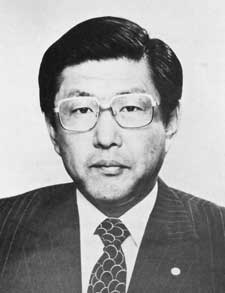
Hideo Tashima
Minolta-35 Innovation
In July 1947, the Allied Occupation Headquarters ordered the temporary suspension of 120 roll film format camera production, since 120 roll film was needed for X ray cameras and was in short supply. Occupation Headquarters encouraged the construction of 35mm film cameras. 13 This led to the decision by Kazuo Tashima to introduce a camera using 35mm film. 5
The Minolta-35 rangefinder was Minolta's first 35mm film format camera. It was designed by Hajimu Miyabe - 宮部甫 - who in the 1940s was Minolta's chief designer 3. Following its 1946 development, the Minolta-35 was introduced in Japan in February, 1947. The Minolta-35 remained in production with surprisingly slight variations until late 1959.
Minolta-35 Series of 35mm Rangefinder Cameras
The descriptions of the progression of Minolta-35 cameras, below, is based on the excellent books Leica Copies by Hans P. Rajner 5 and the book (in French) of Dominique and Jean-Paul Francesch. Histoire de l'Appareil Photographique Minolta (somewhat difficult to find). These descriptions also benefitted from the extensive research and the practical use of Minolta cameras by the expert Andrea Aprà (thanks Andrea !). (A note: Hans Rajner and Andrea Aprà have described designations for each of the different versions of the Minolta-35 which nearly all collectors have adopted. Minolta did not officially name Minolta-35 models prior to the "Model E" which had that name engraved on the camera face. The previous model names assigned by Rajner and Aprà logically work backward from the Model E.)
Minolta-35 Model A

Minolta-35 Model A (or original) camera top of 1947 with "Chiyoda-Kogaku Osaka", the company name and location.
The Minolta-35 when introduced in May, 1947, had a number of innovations that make it an interesting design:
- The rangefinder was integrated into the viewfinder with reasonably good visability. The Canon S-II, introduced in October, 1946 also featured an integrated rangefinder-viewfinder, and the Contax II of 1936 had a rangefinder spot in the center of its viewfinder, with a much longer rangefinder base. Leica, however, did not take this step until the M3 of 1954. 9
- The Minolta-35 had the first self-timer integrated into a Japanese 35mm camera.
- The camera back opened completely like a door on a hinge facilitating loading of film. Other rangefinder cameras of the era used bottom-loading of film, which was less easy (although the distance from the camera lens to the film plain could perhaps be better assured in a rigid, bottom-loading camera body).
- size was also compact at a width of 137mm x height 76mm x depth 62mm. Weight was initially 730 grams or about 1 1/2 pounds - solid but light.
The Minolta-35 Model A produced a 24mm x 32mm negative on 35mm film. This negative size has been called the "Nihon Size" by some, and is described in more detail below in the section "Minolta-35 Picture Size".
The Minolta-35 Model A was produced in three variations during 1947. 13.
Minolta-35 Model A Versions:
- Minolta-35 Model A Version 1: Initial cameras had speed progressions of 1, 2, 5, 10, 25 on the slow speed dial and with a slow speed dial lock, and had the film counter mark on the camera top next to "R".
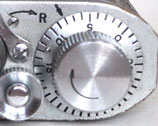
Serial numbers were 0001 up to 04xx and approximately 460 cameras were made. 13
- Minolta-35 Model A Version 2: A second version was similar to the first, with the same slow speed progression, but with the film counter mark moved to the camera edge, just above the camera back hinge.

The slow speed dial lock was retained

Serial numbers were 04xx to 7xx and approximately 300 cameras were made. 13 13
- Minolta-35 Model A Version 3: A third version changed the slow speed dial progression to a geometric series of 1, 2, 4, 8, 25, and there was no dial lock on the slow speed dial. With this third version, there were differences in the style of the mark indexing the selected slow shutter speed: a short line ∣ (early) or a • (later). Serial numbers were 07xx up to 14xx and approximately 720 cameras were made. 13 So, considering gaps in series numbers, about 1,500 cameras of Minolta-35 Model A were made during this first year of 1947.
Minolta-35 Model B
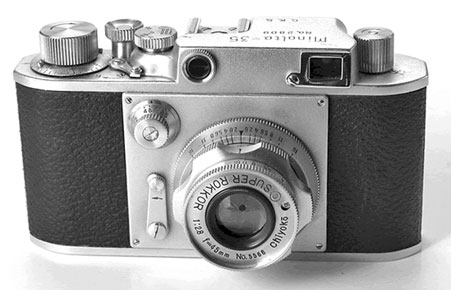
Minolta-35 Model B - the second Minolta-35 model
The Minolta-35 Model B was introduced late in 1947, with several changes to the orignal model, and which were produced in two different versions.
Minolta-35 Model B Versions:
- Minolta-35 Model B Version 1 and 2: slow speeds were a geometric progression of 1, 2, 4, 8, 25 similar to the later versions of the Minolta-35 Model A.
- Minolta-35 Model B Version 1 changing to 2: the identification on the camera top of Version 1 (in small numbers) was "Chiyoda-Kogaku Osaka" as in the Model A. This changed in Minolta-35 Model B Version 2 to C. K. S. (abbreviation of "Chiyoda Kogaku Seiko") on the body top. This was the great majority of Minolta-35 Model B production.

(l) Minolta-35 Model A identification (r) Minolta-35 Model B identification
Also important, because of later changes, was the film advance mechanism which advanced the 35mm film by 7 perforations with each advance - this was later to change.
The Minolta-35 Model B body serial numbers of Version 1 were from 14xx to 15xx with about 50 units manufactured. Serial numbers of Version 2 were from 15xx to about 35xx with about 2000 units manufactured.
The Minolta-35 Model B produced a 24mm x 32mm negative on 35mm film, identical to the previous Model A (both models measured with calipers by me).
Minolta-35 Model C
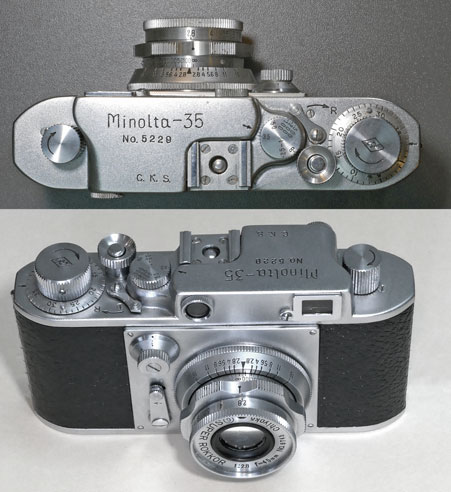
Minolta-35 Model C - the third Minolta-35 model
The Minolta-35 Model C was introduced in May 1948 with an increased image size of 24mm X 33mm. This new image size came closer to the standard 35mm film image size (24mm x 36mm). Also, the film advance mechanism now advanced the 35mm film by 8 perforations, and important change.
This longer film advance effectively eliminated the supposed economies of the "Nihon Size" negatives (see the description Minolta-35 Picture Size, below), since the same amount of film was used as with the larger 24mm x 36mm negative size of other cameras. However, it avoided that film exposed by a Minolta-35 Model C would be cut up in the automated film processing equipment widely used. This change was apparently sufficient for the camera to be approved for sale in the military Post Exchange system, which had previously objected to the non-standard negative size. This can be seen in the Minolta-35 Model C, above which has the Katakana character symbols equivalent to "CPO". "CPO" was stamped on Post Exchange merchandise to prevent it from being sold in the Japanese domestic market. This was during Allied occupation of Japan 1945-1949.

Minolta-35 Model C Versions:
- Minolta-35 Model C Version 1: Early models of the Model C - Version 1 - required the photographer to look at the camera from the front to read the distance and slow-speed dial.
- Minolta-35 Model C Version 2: In Version 2, Minolta changed the camera body such that the readings on the lens and the slow speed shutter dial could be read from above.
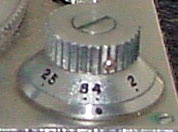
Minolta-35 Model C Version 2 - with improved top view of settings
The Minolta-35 Model C Version 1 had body serial numbers of 4xxx to 48xx and were produced in about 850 units. Version 2 had body serial numbers of 47xx to 8xxx (with some early overlap with Version 1 serial numbers) and were produced in about 3,300 units.
Minolta-35 Model D
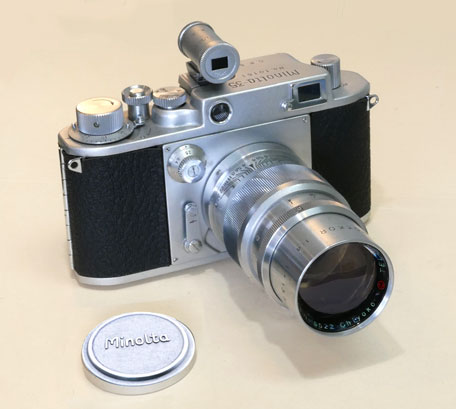
Minolta-35 Model D with Super Rokkor 13.5 cm f4.0 telephoto
The Minolta-35 Model D was introduced in March of 1949 5. This was the first Minolta with flash synchronization, an important innovation. The flash connection pin was located in the accessory shoe allowing a shoe connection to a Minolta flash using flash bulbs. Electronic strobe flash synchronization came four years later with the Minolta-35 Model II.
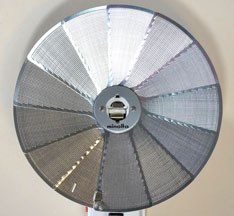
The Minolta-35 Model D seems to be the first Japanese 35mm camera with flash synchronization - Canon introduced their flash synchronization two years later with the Canon IV of 1951.
The Minolta-35 Model D also introduced a small depression in the camera face to facilitate the operating of the lens focusing lever.

Also, the rewind lever moved to a position under the film counter.
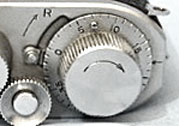
Another small, but useful innovation of the Model D was the inclusion of side lugs for attaching neck straps. Previously, the photographer depended on the camera residing in its leather case to have use of neck straps.

Minolta-35 Model D Versions:
- Minolta-35 Model D Version 1: There were two versions of the Minolta-35 Model D made during production. In Version 1, the negative size remained 24 x 33 mm as in the Model C.
- Minolta-35 Model D Version 2: An important change in Version 2 was increasing the negative image size from 24 x 33 mm to 24 x 34 mm in Version 2. The viewfinder window was slightly changed to correspond to the increased image size.
The Minolta-35 Model D Version 1 body serial numbers were in the range 9001 to 109xx with about 1,900 cameras manufactured. Version 2 body serial numbers were in the range 107xx to 122xx, again with some overlap with Version 1 serial numbers. There were about 1,500 Minolta-35 Model D Version 2 produced.
Minolta-35 Model E
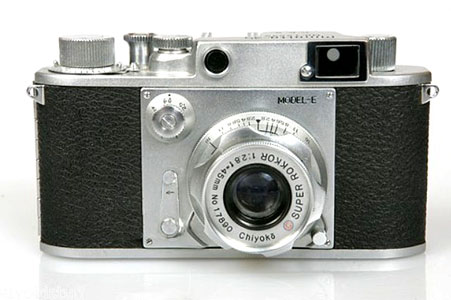
Minolta-35 Model E was introduced in November 1951. The Model E also had synchronization for flash bulbs, but the connector pin socket was moved to the back of the camera below the accessory shoe.

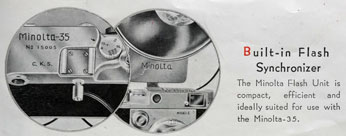
Another advantage of the Minolta-35 Model E was the inclusion of a diaptor adjustment in the rangefinder/viewfinder, which was an aid for those who wore eyeglasses or who were near-sighted. The diaptor adjustment was made by rotating a ring surrounting the viewfinder view port.
The single version of the Minolta-35 Model E was produced in body serial numbers 15001 - 177xx. About 2,700 units were produced 1951-1952.
The Minolta-35 Model E produced a 24mm x 34.5mm negative on 35mm film.
Minolta-35 Model F
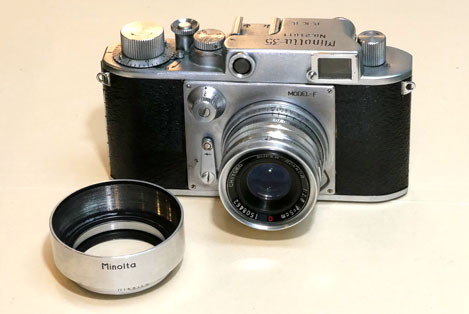
my 1953 Minolta-35 Model F with a Super Rokkor 5cm f2.8 of 1954
In late 1952, Chiyoda-Kogaku introduced the Minolta-35 Model F with the model name on the camera face. Minolta had increased the size of the viewfinder, and had retained the diopter adjustment by rotating the viewfinder eyepiece to adjust diopter settings.
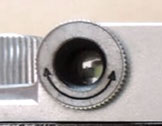
The Minolta-35 Model F also featured flash synchronization, now improved to using a standard coaxial PC socket. Canon by this time had introduced flash synchronization on the Canon IV, but with a less convenient large flash rail on the camera side.
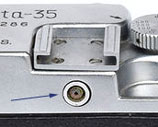
Minolta-35 Model F coaxial flash connection
The Minolta-35 Model F was produced in two production series. The first was with body serial numbers in the 17xxx series, with some overlap with The Minolta-35 Model E serial numbers. The second Model F production was with body serial numbers 20001 to 26xxx. During the two production runs, about 6,500 Minolta-35 Model F cameras were manufactured. 13
The Minolta-35 Model F produced a 24mm x 34.5mm negative on 35mm film (measured with calipers).
Minolta-35 Model II
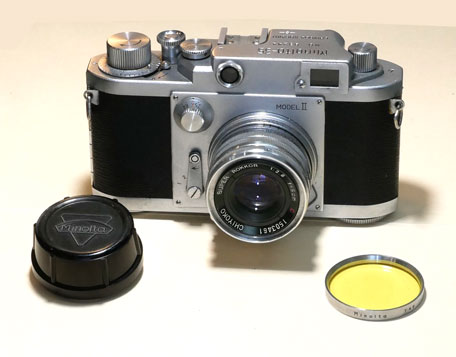
Minolta-35 Model II with a new Super Rokkor 50mm f2.8 lens
Minolta made significant revisions to their new Minolta-35 Model II, introduced in March 1953. During the production of this camera, Minolta made some significant changes to the camera body, all intended to strengthen the structure.
The Minolta-35 Model II in the second version, the camera base plate and the superstructure camera top were both made stronger. The base plate was deepened and strengthed with addition of a large camera back opening wheel, and a more massive tripod socket.

Also, during the later Model II production, not only was the top structure strengthened, but also the accessory shoe was altered, adding pressure balls to assure a tighter grip of items inserted in the accessory shoe.
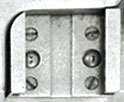
Minolta also decided to bring back the company name to the camera. Early versions of the Model II were labeled simply C.K.S. The later versions restored the company name "Choyoda Kogaku" to the camera top (but without "Osaka").

(l) Minolta-35 Model II early series labeled "C.K.S." and plain accessory shoe
(l) Minolta-35 Model II later series labeled "Chiyoda Kogaku" and accessory shoe with pressure balls
Two new standard lenses were introduced by Minolta during the Minolta-35 Model II production: the Super Rokkor 5cm f2.0 and Super Rokkor 5cm f2.8. Both were fine lenses, able to gain further successes for the Minolta-35 range. Flash synchronization was maintained, and a red "X" was added to the slow speed dial between 8 and 25 to indicate the correct shutter setting for flash synchronization.
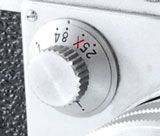
Taking all these variations of the Model II, four versions are usually descibed.
Minolta-35 Model II Versions:
- Minolta-35 Model II Version 1 was the older Minolta-35 body and C.K.S. body labeling. This version sold about 13,000 units in two production series with camera serial numbers 35001-42xxx and a second series 450xx-49xxx. 13
- Minolta-35 Model II Version 2 was the older Minolta-35 body labeled "Choyoda Kogaku". This version sold about 11,000 units with camera serial numbers 46xxx-59xxx.
- Minolta-35 Model II Version 3 was in the new stronger body labeled "Choyoda Kogaku", with the accessory shoe without pressure balls. This version sold about 17,000 units with camera serial numbers 70001-89xxx.
- Minolta-35 Model II Version 4 was produced in the new body labeled "Choyoda Kogaku", with a new accessory shoe with pressure balls. This version sold about 16,000 units with camera serial numbers 87xxx-102xxx with some serial number overlap with Version 3.
The Minolta-35 Model II produced a 24mm x 34.5mm negative on 35mm film.
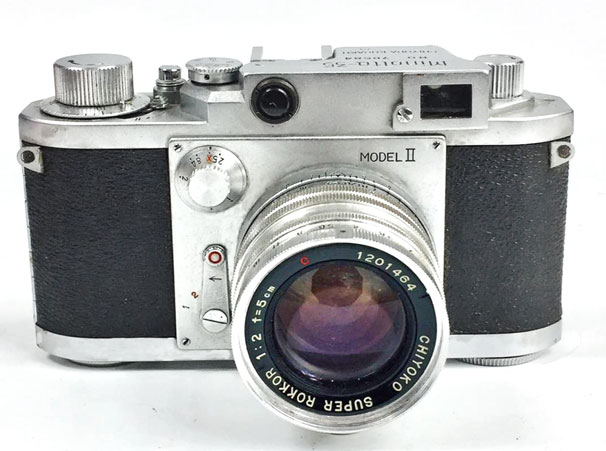
Minolta-35 Model II camera between 1953 and 1958 in its various versions seems to have sold by far the most units of any Minolta-35 and can be found today in quantity and in good condition in secondary markets. In good condition, it can be a good user camera, and its two dial shutter has often proved more reliable than the single dial shutters which became popular on other cameras of that era. A good Model II can be a user's camera, whose price has not been bid to exorbitant levels by collectors.
Introduction of the new Minolta Model-35 IIB
Minolta introduced its further (and last) Minolta-35 model in May 1958. It was with the Minolta-35 Model IIB of 1958 that Minolta first adopted the 24mm x 36mm image size. 5
The several changes were intended to produce a 35mm rangefinder with interchangeable M39 lenses competitive with Canon, Nikon, Leica, but at a much lower price.
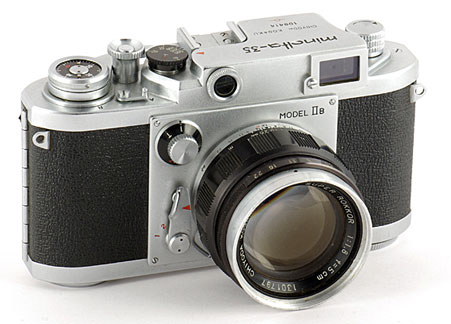
Minolta Model IIB of 1958 with the Super Rokkor 5cm f1.8 lens
The Model IIB added a film advance lever, and offered the 5cm f1.8 Super Rokkor as its standard lens. The Model IIB still had a rotating shutter dial, split at 1/25 with a slow speed dial on the camera front. By this time, Canon, Nikon and Leica had introduced a single, non-rotating shutter speed dial. Canon had already introduced a trigger winder built into the body of the Canon VT in early 1956 and a film advance lever on the Canon L2 late in 1956.
The Minolta-35 Model IIB was produced in body serial numbers 105xxx - 113xxx.
Minolta Rangefinder Construction
The Minolta-35 had a rangefinder base of 40mm (compared with the Canon S-II base of 39mm and the Leica IIIg base of 39mm). The reversed Galileo viewfinder optics provided an effective magnification of 0.33 times real life, providing the effective rangefinder base of only 13mm, relatively short for longer focal length lenses.
This rangefinder design continued until the Model F in 1952. With the Model F, magnification was increased to 0.7X, giving an effective rangefinder base of 28mm. Finally, in the Model II-B, the viewfinder magnification was increased to 0.8X, giving an effective rangefinder base of 32mm.
The Minolta Sky of 1957
In late 1957, prior to the lauch of the Minolta-35 Model IIB, Minolta is said to have produced a run of 100 35mm rangefinder cameras called the "Minolta Sky". The name Sky stands for Shashin Kikai Yarikake
- しゃしんきかい やりかけ which means a prototype. 20 These were not commericalized; some sources said they were given as gifts to Minolta employees and friends, 20, but this seems unlikely, since the only body ever seen was serial number 100001, now in a Minulta museum.
Unlike the Minolta-35 cameras which used the M39 screw lens mount, the Minolta Sky employed a bayonet lens mount, perhaps to compete with the Leica M3 lens mount. Also like the Leica, the rangefinder gave automatic viewfinder images for the 50mm, 90mm, and 135mm lenses as they were mounted, with parallax correction. It had a single, non-rotating shutter speed dial with speeds to 1/1000 second.
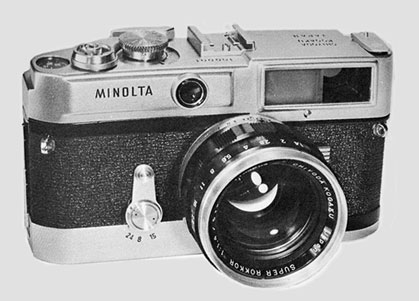
the Minolta Sky prototype rangefinder of 1957 with the Super Rokkor 5cm f1.4 lens
The Minolta Sky rangefinder had a base length of 62 mm. The rangefinder image size was 1:1, allowing shooting with both eyes open. The camera was synchronized for both flash bulbs and electronic flash.
The Minolta Sky with a 3 claw bayonet opening of 21mm, was intended to have a broad range of Super Rokkor lenses. As a prototype, it was shown with Super Rokkor a 25mm f3.5 wide angle and a 135mm f2.8 telephoto, as well as the Super Rokkor 5cm f1.4 lens.
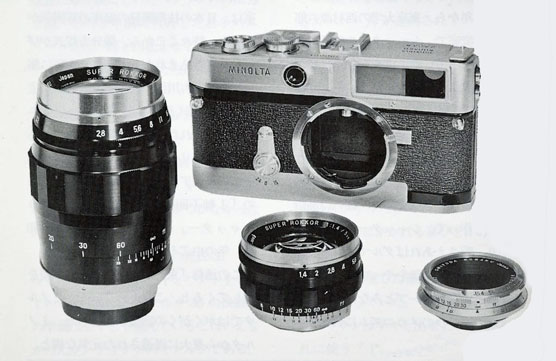
Minolta-35 Rangefinder Image Size
The leading publications covering the Minolta-35, Hans P. Rajner Leica Copies, Dominique and Jean-Paul Francesch Histoire de l'Appareil Photographique Minolta, and certain internet sites give different dates and sizes for the image size produced by the various Minolta-35 models. Consequently, I have used precision calipers to measure the openings of each model. These dimensions are used in the descriptions on this page.
The Minolta-35 on its introduction in 1947 produced an image size of 24mm x 32mm on 35mm film. This has sometimes been called the "Nihon Size", and was used by the Nikon I of 1948, by the Olympus 35 I, and the Minion 35, both of 1948, and others.
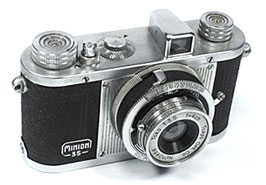
the Minion 35 of 1948 which produced a 24mm x 32mm negative on 35mm film - manufactured by the company which became Topcon
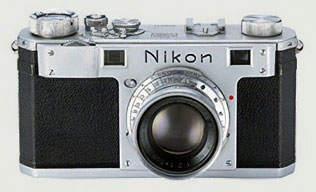
the Nikon I of 1948 also with a 24mm x 32mm format.
In reference to the "Nihon Size", Nikon in its official website sites wrote: 16
"The reasons to adopt the 24 x 32 mm format were:
- The 3:4 proportion seemed to have better proportions than the "Leica" format (2:3).
- It could take 40 frames and was more economical than the "Leica" format of 36 frames.
- The standard of the slide projector provided by the Japanese Ministry of Education was 24 x 32 mm."
The 24mm x 32mm image size was used by the Minolta-35 Model A and Model B. With the Model C, image size was slightly increased to 24mm x 33mm in later Models D was increased to 24mm x 34mm. The Minolta-35 Model E, Model F, and Minolta Model II produced a 24mm x 34.5mm negative on 35mm film. Reference books, such as the excellent Leica Copies by Hans P. Rajner 5 state that the Minolta-35 Model E has an image size of "24x34mm" 5 However, Minolta literature packed with the Model E states that the image size was 24mm x 34.5mm, confirmed by my measurements.
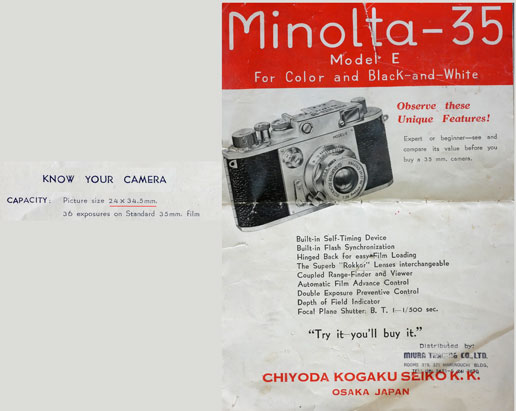
It was with the Minolta-35 Model IIB of 1958 that Minolta first adopted the 24mm x 36mm image size. 5
Nikon with the Nikon M of 1950 had increased negative size to 24mm x 34mm and continued in the 1951 Nikon S. The Nikon S2 of 1954 made its final increase to 24mm x 36mm. 16
A potential negative consequence of the "Nihon Size" image was encountered with the automatic film processing machinery which was used even in the 1930s and 1940s. These machines weree automated for the 24mm x 36mm image format. This included for the cutting and mounting of 35mm color slides. The "Nihon size" images would then have had a tendency to be cut up in the automated machinery.
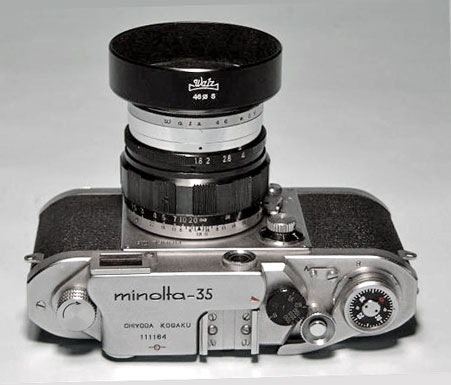
Minolta-35 Model IIB with lens hood
You can click on the links in the table below to consult other pages of the canonrangfinder.org site.
| Navigation: Click Below to Jump to Desired Subject Page | ||
|---|---|---|
| Canon Rangefinder Cameras - 1 | Canon Rangefinder Cameras - 2 | Canon Rangefinder Lenses |
| Canon Hansa | Canon IIAF, IIAX | Development Nikkor 50mm |
| Canon S | Canon IVSB2 | Canon 19mm |
| Canon J | Canon IIS2, IID2, IIF2 | Canon 25mm |
| Canon NS | Canon VT, Canon L2 | Canon 28mm |
| Canon JS | Canon L1, L3 | Canon 35mm |
| Canon S-I | Canon VT Deluxe | Canon 50mm |
| Canon J-II | Canon VL, VL2 | Canon 85mm |
| Canon S-II | Canon VI-L, VI-T | Canon 100mm |
| Canon IIB | Canon P | Canon 135mm |
| Canon III, IIC, IV | Canon 7 | Canon 200mm-1000mm |
| Canon IIIA, IVF, IVS | Canon 7s | Canon Accessories |
| Canon IIA, IID, IID1 | Nicca Rangefinders | Canon Finders |
| Canon IVSB | Minolta Rangefinders | Minolta Lenses |
| Canon IIF, IIS | Other Rangefinders | other M39 lenses |
| Go to canonrangefinder.com home page | ||
Any additions or corrections to these pages would be welcome simply by contacting this site as shown at the foot of this page .
Footnotes:
1 Dechert, Peter. Canon Rangefinder Cameras 1933-1968. Hove Collectors Books. West Sussex, United Kingdom. 1985. ISBN 0-906447-30-5.
Peter Dechert's book is the most important expert source of information regarding Canon Rangefinder Cameras.
2 Kitchingman, Peter. Canon M39 Rangefinder Lenses 1939-1971. A Collector's Guide. Published by Peter Kitchingman. Perth, Australia. 2008. ISBN 978-0-646-48144-9.
Peter Kitchingman's book is the definitive study of the more than three decades of M39 format camera lenses developed for Canon Rangefinder Cameras.
3 Nostalgic Canon Camera Book. 懐かしいキヤノン EI Publishing Co. Ltd. Tokyo, Japan. June 2003.
Peter Kitchingman's book is the definitive study of the more than three decades of M39 format camera lenses developed for Canon Rangefinder Cameras.
4 "Canon Camera Museum" history website. https://global.canon/en/c-museum/history/ published by Canon, Inc. accessed in 2019.
5 Rajner, Hans P. (author), John Wade (editor). Leica Copies. Classic Collections Publications. London, UK. ISBN 13: 9781874485056
Hans P. Rajner's book is an excellently detailed and carefully researched study of camera from around the world which used the Leica M39 lens mount and the same lens to film plane distance.
7 Dechert, Peter. Canon Single Lens Reflex Cameras 1959-1991. Historical Camera Publications. Yakima, Washington. 1992. ISBN 1-879561-04-2.
8 Tomlinson, Shawn M. The Film Photography Book. Lulu Pulbications. 2016. ISBN: 9781365263972
9 Sartorius, Ghester. Identifying Leica Lenses. Classic Camera 19. Tokyo, Japan. 2001. ISBN 4-257-12029-0
10 website http://www.nicovandijk.net/rflensmatrix.htm consulted 2019.
11 O'Reagan, Douglas M. Allied Exploitation of German Science after World War II. Johns Hopkins University Press. Baltimore, Maryland. 2019. ISBN 9781421428888
12 website www.canonrangefinder.servehttp.com consulted 2008.
13 Minolta expert Andrea Aprà has posted information on minoltarangefinders group and other groups and further detailed information by email. (thanks Andrea !)
14 website http://www.collection-appareils.fr/objectifs/ consulted 2019.
15 Small, Marc James. Non-Leitz Leica Thread-Mount Lenses. Wittig Books. Hückelhoven, Germany. 1997. ISBN 3-930359-47-2.
16 the Nikon Corporation website: https://imaging.nikon.com/history/ consulted 2019.
17 p 152. Ray, Sidney F. Photographic Lens ISBN 9780240510323
18 website http://www.rokkorfiles.com/Lens%20History.html accessed 2019
19 email from Steven Pollock of December 2020
20 Dominique and Jean-Paul Francesch. Histoire de l'Appareil Photographique Minolta Dessain et Toira. Paris. 1985.
21 Asahi Camera.; Tokyo March 1954, February 1955.
If you have any comments or questions about this Canon Rangefinder site, please e-mail me (Larry Huffman) at e-mail address: [email protected]